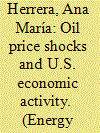| Srl | Item |
| 1 |
ID:
166449


|
|
|
|
|
| Summary/Abstract |
Our understanding of the sources of oil price fluctuations and their effects on the U.S. economy has undergone important transformations in the last decades. First, several studies have demonstrated the importance of identifying the causes of oil price fluctuations, whether they are driven by demand or supply shocks, instead of assuming that oil price changes are exogenous to the evolution of the world's economic activity. Second, new methodologies have allowed researchers to re-evaluate the functional form of the relationship between oil prices and U.S. GDP, its components and job flows. Third, significant advances have been made in understanding the relationship between oil price uncertainty, news, economic policy uncertainty and aggregate economic activity. Finally, investigations into the time-varying nature of oil price-macroeconomy relationship have provided important insights into the reasons why unexpected increases in oil prices appear to shock less now than in the 1970s. This paper reviews the studies that have contributed to these different aspects of the literature.
|
|
|
|
|
|
|
|
|
|
|
|
|
|
|
|
| 2 |
ID:
128164


|
|
|
|
|
| Publication |
2012.
|
| Summary/Abstract |
This paper revisits the resource curse phenomenon in China and differs from the previous studies in four respects: (i) City-level data is used; (ii) A spatial variable is constructed to estimate the diffusion effect of natural resources among cities in the same province; (iii) The impact of resource abundance on economic development is investigated not only at the city level but also at the prefectural level in China; (iv) We use a functional coefficient regression model to deal with city-specific heterogeneity and, at the same time, analyze the transmission mechanism of the resource curse phenomenon. Our empirical results show that there is no significant evidence to support the existence of a resource curse phenomenon in China. On the other hand, we find that the degree of natural resource abundance in a city has a positive diffusion effect on the economic growth of neighboring cities within the same province at the city level, but not at prefectural levels. We attribute this to the urban bias policy.
|
|
|
|
|
|
|
|
|
|
|
|
|
|
|
|